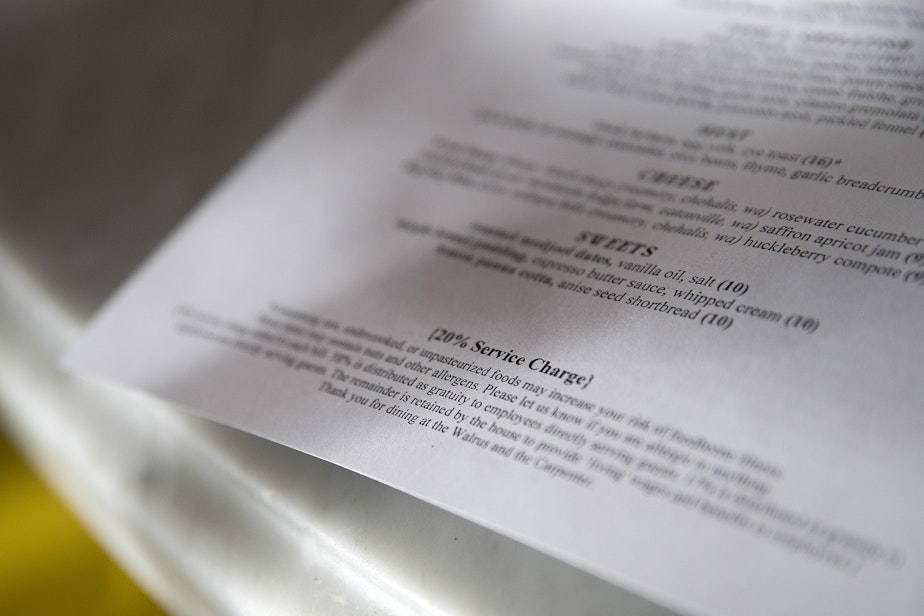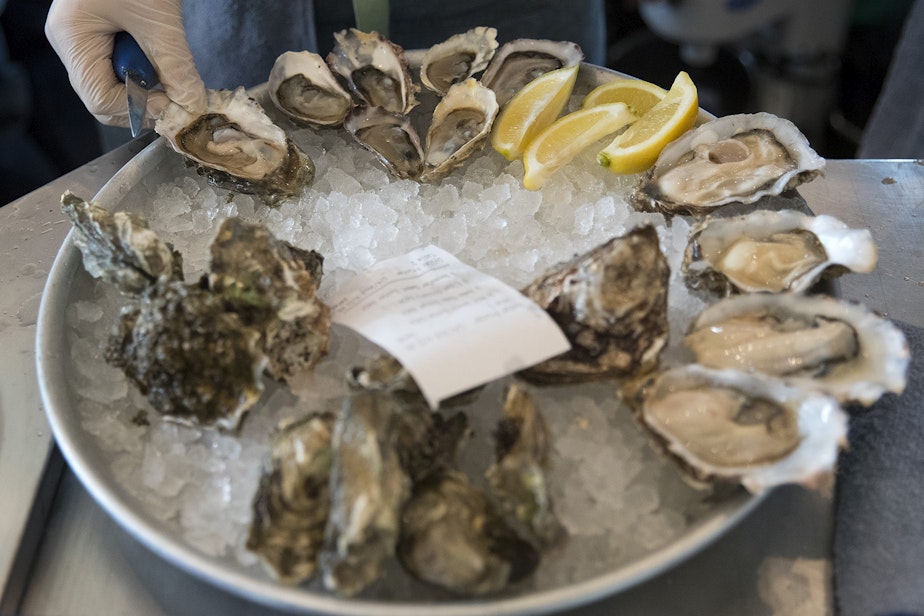In a city with $15 minimum wage, do I still need to leave a tip?
KUOW listener Derek Hanson wanted to know, in a city with a $15 per hour minimum wage, "do I still need to tip?"
The short answer is a full-throated yes. At least, that’s what nearly every server told KUOW.
But the long answer is more complicated.
Seattle is at the epicenter of an anti-tipping movement that sees the practice as unfair to restaurant workers and customers. And there's evidence to suggest tipping contributes to racism and sexism.
Back in early 2015, a small oyster bar in Ballard decided to end tipping as we know it. "I think it's taken a lot of the stress off,” said Dana Forman, who has worked at The Walrus and the Carpenter for nearly a decade.
When the restaurant got rid of tips, Forman said there was a lot of fear and a lot of questions: “What's it going to be like, are we still going to make the same amount of money?"

But, Forman said, the no tip policy has made paychecks more predictable. "There's never that nothing feeling like, 'oh no, that was my only table that night, I can't pay my bills' kind of thing."
This oyster bar launched its no tip policy as a way of addressing increasing costs including a higher minimum wage. Instead, they now have a mandatory 20 percent service charge that’s divvied between waiters, oyster shuckers, and other staff. The fee also helps pay for health benefits, a retirement plan and wages that start above $15 an hour.
In the years since the no tip policy launched, co-owner Jeremy Price said there have been very few complaints from customers, except a handful from mostly older white guys, who say: "I would have left more but now I'm just so offended that you've removed control."
Back in 2015, when the no tip policy went into effect, chef and co-owner Renee Erickson told KUOW customers wanting to be control is part of problem they were hoping to solve. "Being a woman and serving people can be uncomfortable at times, and there's comments that can be made that remind you that you're working for a tip."

Academic research has found that the culture of tipping can perpetuate sexism and racism. Black servers get tipped less, and on the other side of the table, research indicates that wait staff discriminate against black customers believing they won't tip as well. The oyster bar just wanted to be done with all of that.
Since the minimum wage a number of other Seattle restaurant owners like Tom Douglas are also on the no tip bandwagon. Some have gone a step further like Matt Dillon's Bar Ferdinand where there's no service charge and no tips. If you do tip it gets donated to charity.
Searching for the answer to whether customers should still tip got us wondering how did tipping even start? It turns out, Americans didn't always tip like they do today. The custom was imported from Europe after the civil war.
At the time, critics rejected tipping as an aristocratic import — an insult to American workers, not right for our more democratic sensibilities. In 1909, Washington became the first state to pass an anti-tipping law. It lasted four years.

Of course eventually the tip caught on, and these days it's Europeans and other visitors who find our culture of tipping a little strange.
Nuno Guilherme is slurping oysters at the Walrus and the Carpenter, and he said he likes the no tip policy because back home in Portugal, “the establishment already pays their waiters. As a customer, you shouldn't be in charge of that."
So, should you still tip?
Here at the oyster bar, the owners discourage it. There's not even a line for a tip on the bill.
But Dana Forman who works the front of the house admits, “there’s still the thrill when someone will say, that was great, and there will be $20 left on the table."

And there was a resounding yes from all of the servers we spoke with at places that still have a line on the bill for tips.
Kun Choi, for example, is a college student who works part time at a restaurant in the University District. And he says he needs your tip to help pay his rent. Like most servers in Seattle, Choi’s not making $15 an hour. That's only a requirement at the biggest businesses. Mom and pop places can still pay their workers as little as $11.50 an hour, which is around $24,000 a year.
But here in Seattle and Washington state, restaurant workers are relatively well off. In some other states, the "tipped” wage is currently as low as $2.13 per hour, as long as tips bring the worker up to the federal minimum of $7.25 per hour.
Correction, 11:30 a.m., 3/6/18: An earlier version of this story incorrectly described tipping at Ivar’s restaurants. Ivar’s had a no-tipping policy but got rid of it in 2017.

